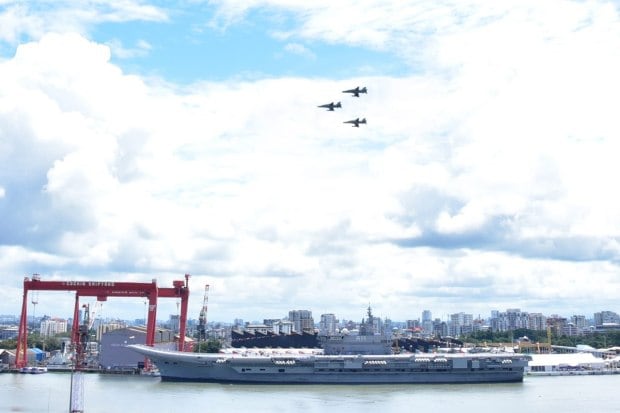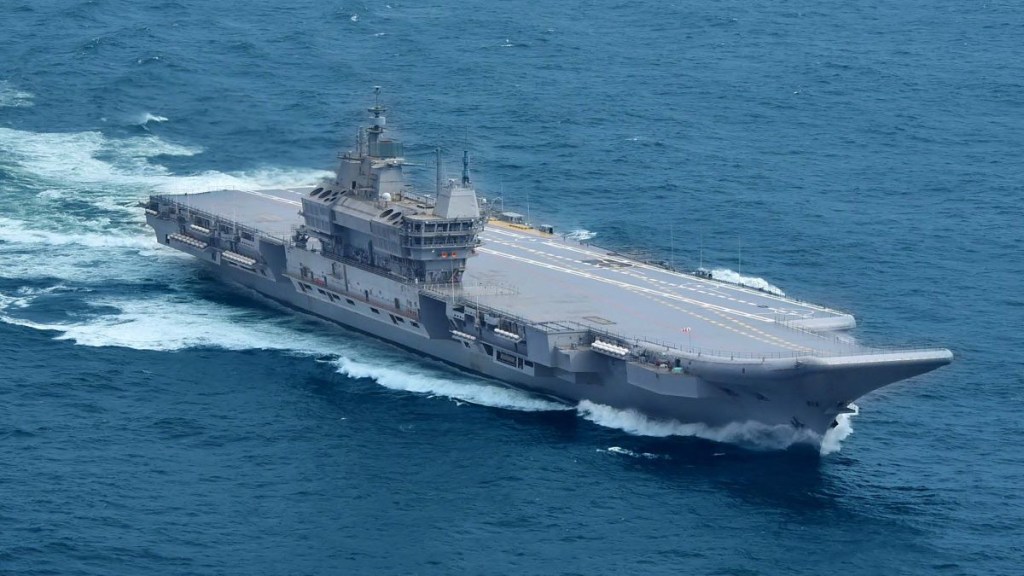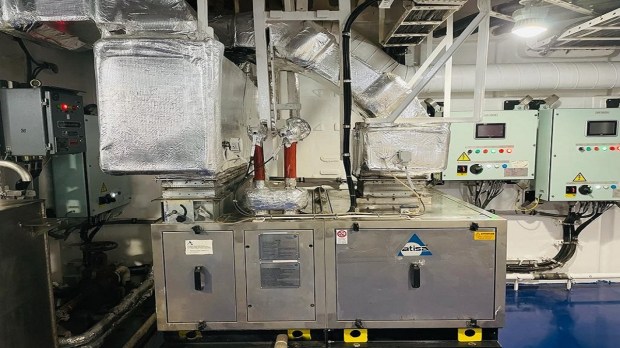Q: India has succeeded in building an entire aircraft carrier from scratch. Can you tell us the range of services and products Johnson Controls offers? How broad is your scope of work and solutions for the armed forces?
A: Aircraft Carrier HVAC systems were a monumental project as far as JCI is concerned. When we won the order in 2010, we knew we would make history as this is India’s first indigenous aircraft carrier. And what’s more, the HVAC systems will provide comfortable cooling to more than 1700 odd people on board and keep all electronics and systems running optimally. If you look at the HVAC system overall, there are seven subsections/systems involved in an aircraft carrier.
Firstly, for the occupants to feel comfortable the temperature should be 24-26 °C within the ship. This is both for the accommodation and electronic and electrical compartments.
Secondly, the chilled water system pipes that run all through the ship are close to 11 km, and they bring chilled water into the air handling units (AHUs) at 6-6.5 °C, which allows the Air Handling units (AHUs) to supply cool air into the compartments. Next, you have the mechanical ventilation system, which, through massive ventilation fans, supplies fresh air and cools all machinery compartments.
Next is the smoke clearance system for the ship, which is typically activated in case of a fire, wherein it removes the smoke in the affected zone, and these smoke extraction systems are planned and implemented zone-wise. The smoke system is one system without which the aircraft carrier could not have sailed because fire onboard the aircraft carrier can be serious.
The next one is the aircraft cooling system which plays an important role in cooling the pilot suit and the entire instrumentation panel while the aircraft is on deck, just prior to kick-starting the engine. The HVAC systems supply keeps the pilot suit at 15 °C, and instrumentation cooling at 12 °C.
-

INS Vikrant HVAC systems
Lastly, the electrical components and electronics related to all HVAC equipment are connected to the zonal panels in each zone. These zonal panels are at the heart of all the HVAC equipment in the fire zone and can also be controlled by these panels. The connectivity to the ship’s Integrated Platform Management Systems (IPMS) is established through these zonal panels, which are based on programmable logic. These seven systems that comprise the HVAC system in an aircraft carrier are unique systems, and that is what makes this undertaking complex and challenging.
Q: Is there any centralised place where all the mechanicals can be connected and operated from the cabin or ship?
A: Yes, the Integrated Platform Management System (IPMS), through which the complete ship’s machinery, HVAC, firefighting systems, damage control systems, etc., can be connected and controlled. As far as HVAC was concerned, we connected each fire zone to a zonal control platform. This is because, we had many equipments, subsystems, ventilation fans, self-contained units, aircraft cooling equipment, and a large number of gas & watertight dampers. Only relevant signals are passed on to the ship’s Integrated Platform Management System. So, you can monitor the parameters of the HVAC equipment, stop equipment, or run equipment, or if it is under maintenance, you can put a tag so that nobody operates it erroneously from the local panels.
When we talk about the HVAC system alone, we are talking about nearly 320 tonnes of ducting materials that have gone inside the ship. So, one can imagine that at the rate of 6-7 tonnes of ducting fabrication and installation per month, it would have taken us approximately 4.5 years to complete the ducting system on board from start to finish.
The reason INS Vikrant took longer is that installation is not the easiest, because so many systems were already running on board, and it was necessary to ensure that one system wasn’t running into the space allocated for another system.
Though we had an 8-tonne plan per year, we saw that over a period of one year, we were able to achieve only 6.5 to 7 tonnes. The ducting work can only start once all the Air Handling Units and ventilation fans are installed. The ship is also divided into nine independent fire zones, such that if any one particular zone sustains damage, the other fire zones will not get affected. This helps curtail fire, and keep the ship afloat, particularly during wartime. In order to achieve this, we had to avoid interconnecting ducts from one fire zone to another. Each fire zone is as good as building a frigate. A frigate has 45 to 50 tonnes of HVAC ducting onboard. If you take nine zones, we were building HVAC systems for 7 frigates concurrently. That is the enormity and complexity of the HVAC system onboard aircraft carriers.
Q: So, you are installing subsystems that are equivalent to installing 7 frigates?
A: That’s right. It’s because aircraft carriers are so humongous that for each fire zone, the equipment and the number of ducts that go in is equal to a frigate of tonnage varying from 5000 to 6000 tonnes. You have roughly 50-60 tonnes of ducts in each frigate for the HVAC system. So, if we work on all these fire zones concurrently, we will still take only five to six years to complete it.
-

Commander Satish Kumar Menon, Director, Navy Systems, India, Johnson Controls.
The normal gestation period for a frigate construction is five to six years. You can imagine the enormity of the work we were involved in. And the first three to four years went into just preparing the Single Line Diagram (SLD) and 2-D drawings. The meticulously prepared 2D drawings would then be assessed by the shipyard design team in 3D, to see that our systems were not in collusion with other shipborne systems. It took nearly 2-4 years to get these drawings, the quality assurance plans, and the factory acceptance tests and procedures approved for all equipment being procured from abroad (mainly from Italy).
The HVAC equipment was guided by naval standards and had to comply with the specific shock requirements. The first four years of building those drawings and going in for factory acceptance trials for all equipment was a humongous task. Then it took approximately two years to finish.
Q: How many of the solutions or parts for carrier Vikrant were made in India?
A: The tender for HVAC systems was given only to global companies for aircraft carriers; hence, the indigenous component was only 35-40% of the total cost of the HVAC order value, which included ducting, fittings, and service components from Johnson Controls India.
As far as HVAC is concerned, Johnson Controls was doing aircraft carrier work for the first time in India. Though we had worked on larger ships in India & Europe and had developed preliminary HVAC designs for UK aircraft carriers, we had excellent design capabilities for building HVAC systems for aircraft carriers that were headquartered in the UK (Global Navy Systems HQ). We had 8-9 design engineers continuously working on such a complex system. As mentioned earlier we had to concurrently build the seven systems and provide a single-line diagram of the ship which indicated the basic sizes of the ducts, the flow rate of air, the velocities, and the fittings used to complete the system.
The shipyard design team then looks at the complex drawings we give them to analyse the system routings and space allocations for ducts and chilled water systems in their 3-D modelling software system. The design process and space allocations are very complex for shipyards too. While we were gearing up for the installation phase of the project, we realised that design was easier than installing because the latter was tricky. At any given time, there were more than 3000 subcontractor personnel and shipyard employees working on board installing various shipborne systems.
Q: As you talked about a 65,000-tonne aircraft carrier in the UK, could there be a new design that is more efficient to fit in the smaller weight category and might have gone through all the processes?
A: Yes. We were looking at it for this particular aircraft carrier, which we were building in India. This had the best design and equipment which were shock tested and had proven its efficacy in earlier ships. Furthermore, we had a good vendor base with whom we already had experience working, and had built all these AHUs and other equipment to defence standards and Indian naval standards. We could quickly source this equipment from these vendors.
The primary change that we made with respect to design was that we brought in AHUs and other equipment in modular construction. So, while the ship was being built, and as decks got closed, lowering equipment into decks that were lower down, would’ve proven cumbersome. The advantage of modular construction is that it would allow us to dismantle the equipment and lower it through ships’ hatches and alleyways, and assemble it once inside.
The ship’s complete ducting system’s Single Line Diagram (SLD) had six revisions, owing only to the changes in the heat load calculations. This is to demonstrate the complexity of this project stemming from every stage of planning and execution. The design was evolving as we went ahead with ducting installations. This phenomenon is called telescopic design.
Q: In the developing stage, as you mentioned, most of the work is completed in different parts of the world. It must have required a lot of modification, testing, and revaluation. Can you explain whether this expertise will be leveraged for aircraft carriers alone, or can it be implemented into other projects?
A: JCI India has already been working with the Indian Navy for a while now. All the four aircraft carriers that the Indian Navy has operated, Viraat, Vikramaditya, Vikrant and now the new Vikrant, have our footprints. If you look at the legacy, Johnson Controls has always been at the forefront of aircraft carrier projects, whether it is chillers or HVAC. The chillers installed on Vikramaditya are running exceptionally well, and so is the HVAC system of INS Vikrant. We have also worked on chillers and HVAC for Corvettes, frigates, the prestigious project P17 (Shivalik Class) and P-28 (ASW corvettes).

An aircraft carrier is something unique – doesn’t get made every day! Once you decide to make an aircraft carrier, then you need to pull in all your resources and work out a plan to execute it, especially knowing the long gestation period of construction (7 to 9 Years). So, we prepared for it and when the ship went for the first sea sortie, we had made history.
Q: So, do you want to use this expertise in other warships? Also, as you mentioned about constructions like P17 or P15, do you have any collaboration with them for the system?
A: We are working on some of the significant warships under construction and are in different stages of production in various shipyards. Johnson Controls is looking for more orders because the ship construction process is progressing in a big way as the Indian Navy wants to reach a certain number of ships in the next four to seven years. We have many ships under construction, and we are constantly bidding for HVAC and chillers.
And the best thing we take forward from INS Vikrant is that we are seamlessly working towards the Make in India dream. We have now identified local vendors who can build modular AHUs/ vent fans, SCUs, and aircraft cooling equipment, and integrate the latest technologies with JCI to make them truly sustainable. The aircraft carrier that will follow will be fully indigenised, and we at JCI are committed to the Make in India effort and will put in all our efforts to install only indigenised equipment on board.



